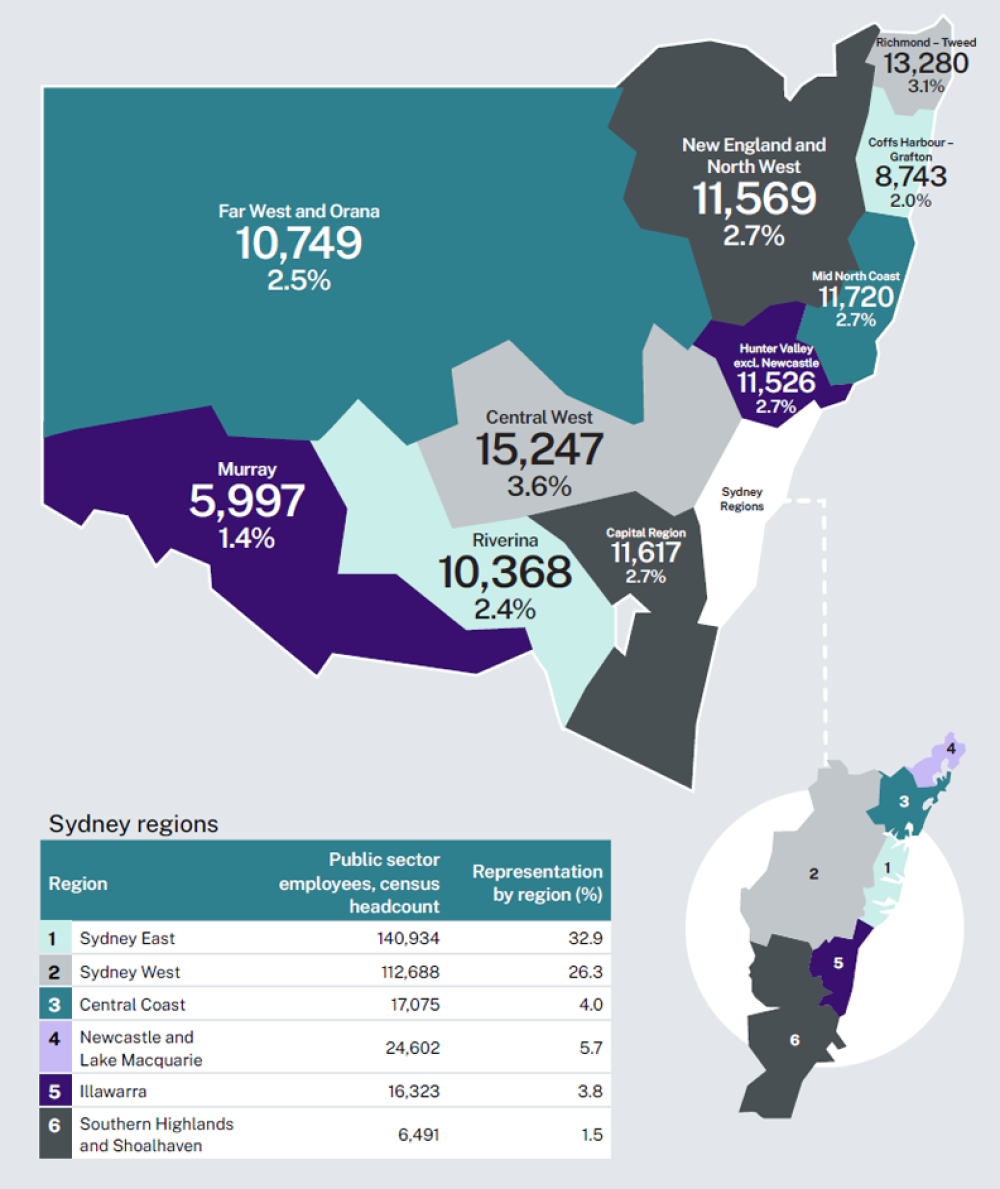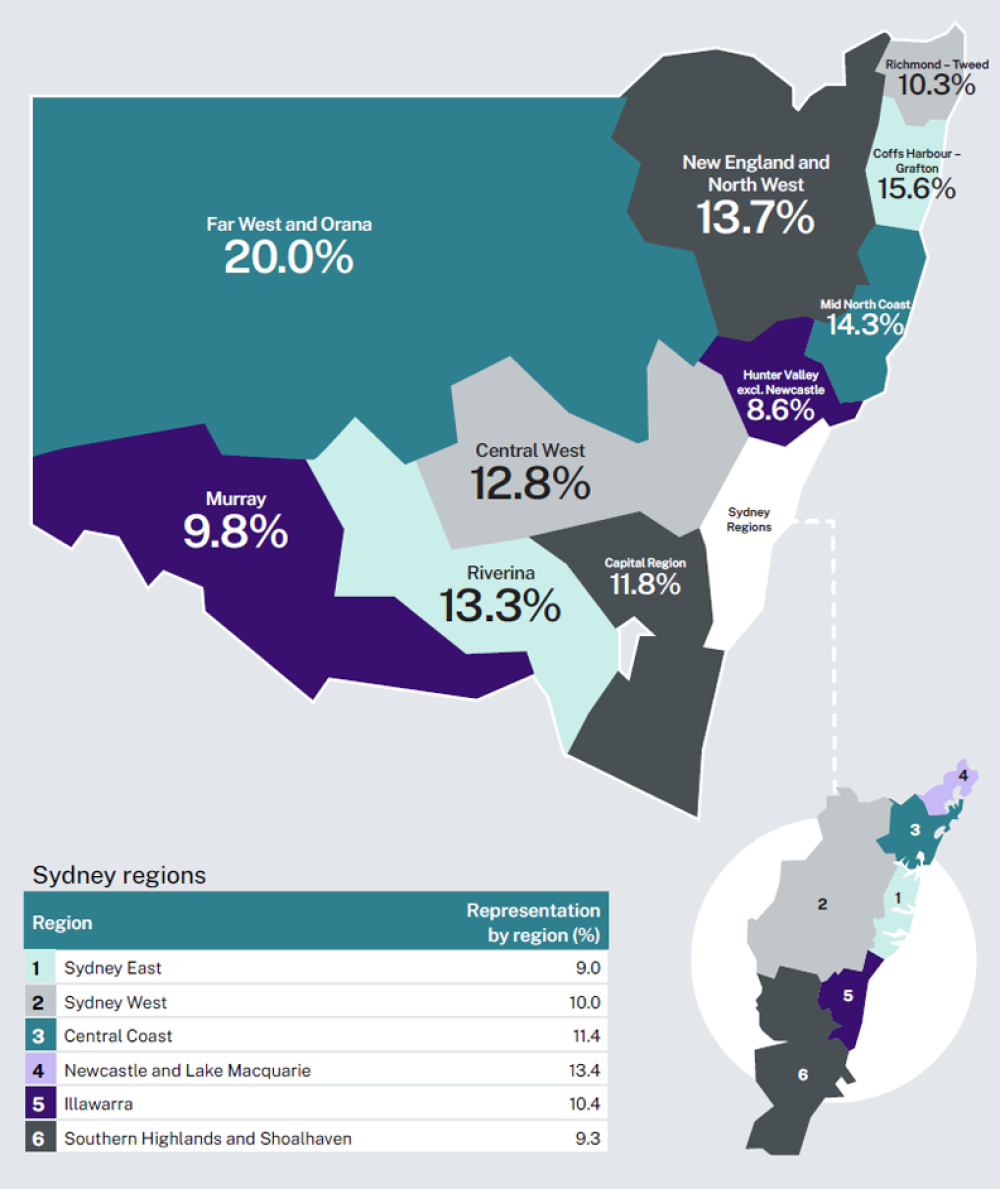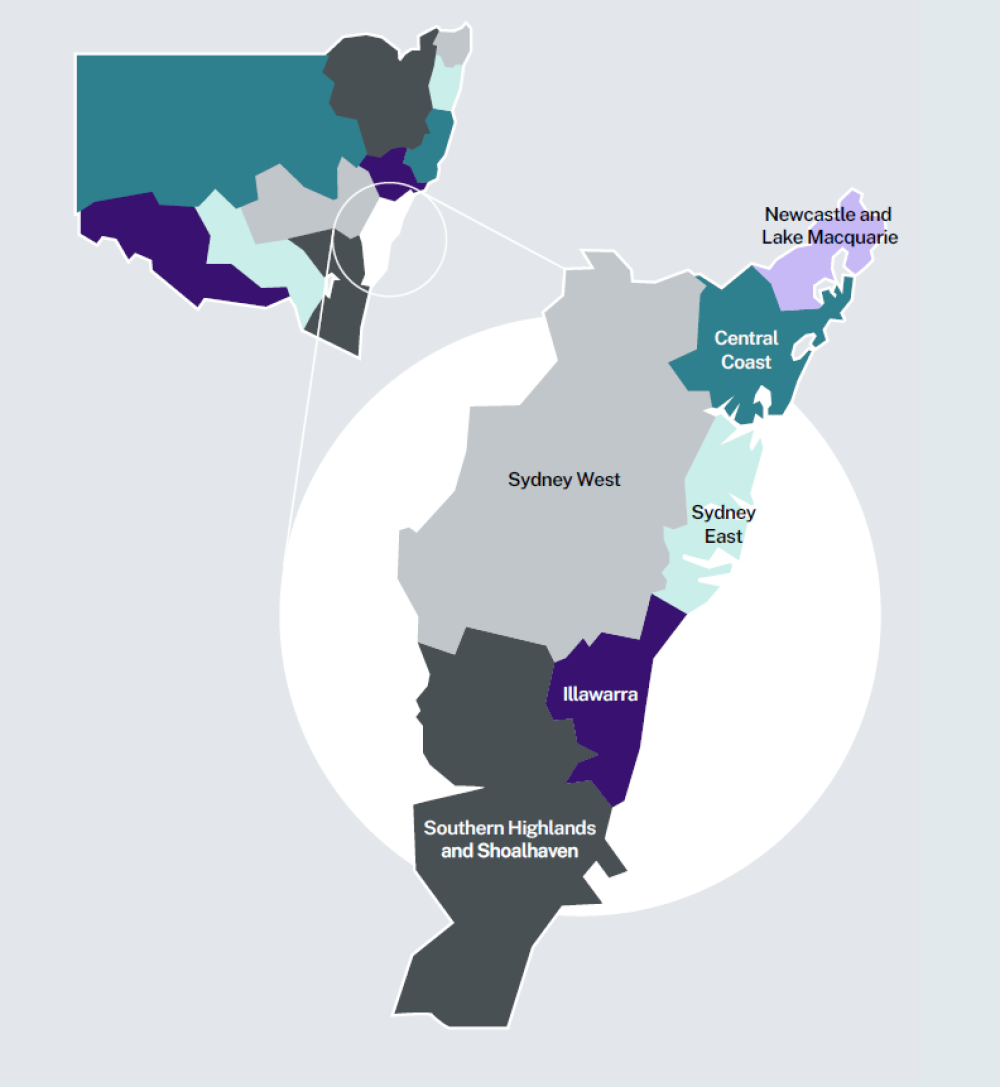34.3%
of employees were located in regional areas at census date
40.9%
of employees were located outside Sydney at census date
The NSW public sector is the largest employer in Australia, accounting for more than 10% of employment in the state. As such, it has a large impact on the NSW workforce. While most roles are in metropolitan areas, the NSW public sector provides a significant proportion of all employment in regional NSW.1
This analysis is based on employees’ work locations in the Workforce Profile data submitted by departments and agencies. It does not reflect any work-from-home arrangements that were part of the response to the COVID-19 pandemic.
In 2021, 34.3% of public sector employees worked in regional areas, with all Sydney local government areas (LGAs) as well as Newcastle and Wollongong LGAs classified as metropolitan.
Comparing Sydney with the rest of the state,2 59.1% of NSW public sector employees worked in Sydney (see Figure 11.1, Sydney East and Sydney West combined). While most of the public sector workforce was located in Sydney, the proportion of public sector employees working outside Sydney was higher than the proportion of the resident population in these areas3 (40.9% compared to 38.5%).
Figure 11.1: NSW public sector employees by region, census headcount, 2021

NSW Regions
| Region | Census headcount | Representation by region (%) |
|---|---|---|
| Hunter Valley excl. Newcastle | 11,526 | 2.7 |
| Mid North Coast | 11,720 | 2.7 |
| New England and North West | 11,569 | 2.7 |
| Far West and Orana | 10,749 | 2.5 |
| Coffs Harbour – Grafton | 8,743 | 2.0 |
| Richmond – Tweed | 13,280 | 3.1 |
| Capital Region | 11,617 | 2.7 |
| Riverina | 10,368 | 2.4 |
| Murray | 5,997 | 1.4 |
| Central West | 15,247 | 3.6 |
Greater Sydney area
| Region | Public sector employees, census headcount | Representation by region (%) |
|---|---|---|
| Sydney East | 140,934 | 32.9 |
| Sydney West | 112,688 | 26.3 |
| Central Coast | 17,075 | 4.0 |
| Newcastle and Lake Macquarie | 24,602 | 5.7 |
| Illawarra | 16,323 | 3.8 |
| Southern Highlands and Shoalhaven | 6,491 | 1.5 |
Regional profiles
Key statistics for each region are displayed in Table 11.1, which compares 2021 with 2020. The distribution of census FTE by region and service is shown in Table 11.2.
In 2021, regions outside Sydney accounted for 39.7% of FTE, while Sydney East and Sydney West together accounted for 60.3%. In line with previous years, the highest proportion of employees in the government sector working outside Sydney were in Teaching Service (44.2%) and the NSW Health Service (41.9%), followed by Other Crown services (38.8%), the Public Service (35.7%), the NSW Police Force (35.3%) and the Transport Service (21.9%).
Table 11.1: Key statistics by region, 2020-213
| Work region | Estimated resident population | Census period FTE 2020 | Census period FTE 2021 | Change census period FTE 2020 to 2021 (%) | Median age (years) | Median salary non-casual ($) | Median tenure non casual (years in agency) | Part-time non-casual (%) |
|---|---|---|---|---|---|---|---|---|
| Capital Region | 232,799 | 9,082 | 9,341 | 2.86 | 47 | 88,449 | 8.8 | 34.19 |
| Central Coast | 345,857 | 13,715 | 14,008 | 2.14 | 44 | 90,394 | 9.4 | 33.51 |
| Central West | 213,714 | 12,243 | 12,571 | 2.68 | 45 | 87,157 | 8.8 | 30.66 |
| Coffs Harbour – Grafton | 142,570 | 6,966 | 7,120 | 2.20 | 47 | 90,394 | 9.2 | 37.23 |
| Far West and Orana | 116,440 | 8,968 | 9,036 | 0.76 | 43 | 82,573 | 7.4 | 26.11 |
| Hunter Valley excl. Newcastle | 285,141 | 9,140 | 9,381 | 2.64 | 44 | 87,157 | 9.2 | 33.27 |
| Illawarra | 317,988 | 12,914 | 13,209 | 2.29 | 44 | 90,394 | 9.7 | 33.55 |
| Mid North Coast | 224,808 | 9,285 | 9,658 | 4.01 | 47 | 90,394 | 9.7 | 34.63 |
| Murray | 122,056 | 4,581 | 4,694 | 2.47 | 46 | 88,416 | 8.5 | 39.05 |
| New England and North West | 186,312 | 9,339 | 9,460 | 1.29 | 45 | 86,862 | 8.6 | 34.81 |
| Newcastle and Lake Macquarie | 382,537 | 19,633 | 19,855 | 1.13 | 44 | 90,394 | 9.4 | 35.83 |
| Richmond – Tweed | 255,304 | 10,214 | 10,492 | 2.72 | 47 | 90,394 | 9.4 | 42.51 |
| Riverina | 161,929 | 8,337 | 8,502 | 1.97 | 44 | 87,157 | 7.9 | 32.88 |
| Southern Highlands and Shoalhaven | 158,728 | 5,080 | 5,196 | 2.28 | 46 | 87,157 | 9.1 | 37.13 |
| Sydney East | 2,782,668 | 116,053 | 119,834 | 3.26 | 43 | 94,601 | 6.8 | 21.55 |
| Sydney West | 2,238,681 | 91,549 | 96,386 | 5.28 | 42 | 91,111 | 8.2 | 22.54 |
*0.4% of census period FTE is not mapped to any Australian Bureau of Statistics’ Statistical Area Level 4 (SA4) for NSW because of postcode and/or suburb data that is missing or outside NSW.
Table 11.2: Census period FTE by service and region, public sector, 2021
| Work region | Public Service | NSW Health Service | NSW Police Force | Teaching Service | Transport Service | Other Crown services | External to government sector | State owned corporations |
|---|---|---|---|---|---|---|---|---|
| Capital region | 1,964 | 2,994 | 685 | 2,198 | 201 | 960 | 0 | 340 |
| Central Coast | 2,108 | 6,191 | 781 | 3,225 | 140 | 1,562 | 0 | 0 |
| Central West | 3,214 | 4,140 | 576 | 2,397 | 237 | 1,596 | 0 | 412 |
| Coffs Harbour - Grafton | 1,141 | 2,659 | 289 | 1,469 | 414 | 845 | 0 | 303 |
| Far West and Orana | 2,134 | 2,815 | 580 | 1,723 | 273 | 1,124 | 4 | 382 |
| Hunter Valley excl. Newcastle | 2,506 | 2,177 | 503 | 2,708 | 62 | 1,276 | 0 | 149 |
| Illawarra | 1,636 | 5,409 | 647 | 2,983 | 466 | 1,989 | 0 | 80 |
| Mid-North Coast | 1,242 | 3,360 | 388 | 2,207 | 69 | 1,329 | 1 | 1,061 |
| Murray | 668 | 1,531 | 287 | 1,180 | 108 | 693 | 0 | 227 |
| New England and North West | 1,671 | 3,148 | 563 | 2,220 | 166 | 1,327 | 2 | 362 |
| Newcastle and Lake Macquarie | 2,688 | 9,312 | 799 | 3,669 | 597 | 2,348 | 1 | 441 |
| Richmond - Tweed | 1,160 | 4,813 | 558 | 2,321 | 118 | 1,270 | 0 | 253 |
| Riverina | 1,409 | 3,141 | 397 | 1,772 | 302 | 1,096 | 3 | 382 |
| Southern Highlands and Shoalhaven | 972 | 1,795 | 249 | 1,432 | 40 | 689 | 0 | 19 |
| Sydney East | 24,516 | 41,192 | 6,767 | 18,320 | 9,516 | 17,065 | 1,096 | 1,361 |
| Sydney West | 19,675 | 32,821 | 6,613 | 21,476 | 1,849 | 11,474 | 3 | 2,476 |
NSW public sector relative to the NSW workforce
The NSW public sector accounted for 10.4% of the approximately 4,161,993 people employed in NSW at June 2021.4 This is a slight decrease from 10.5% last year and is likely due to a return to the number of employed persons in NSW before the COVID-19 pandemic (214,861 more employed persons than in 2020 and 10,031 more employed persons than in 2019).
Analysis of the geographic distribution of NSW public sector employees (including casuals) relative to the overall workforce5 shows where government employment contributed the most to local and regional economies. Figure 11.2 shows the percentage of employed persons who were NSW public sector employees ranged from 8.6% to 20% across the regions in 2021. In most regions, 10% to 15% of employed persons worked for the NSW public sector, with notable exceptions being Far West and Orana (20.0%) and Coffs Harbour – Grafton (15.6%).
Figure 11.3: Public sector employees as a proportion of NSW employed persons by region, 2021

| Region | Percentage |
|---|---|
| Hunter Valley excl. Newcastle | 8.6 |
| Sydney East | 9.0 |
| Southern Highlands and Shoalhaven | 9.3 |
| Murray | 9.8 |
| Sydney West | 10.0 |
| Richmond – Tweed | 10.3 |
| Illawarra | 10.4 |
| Central Coast | 11.4 |
| Capital Region | 11.8 |
| Central West | 12.8 |
| Riverina | 13.3 |
| Newcastle and Lake Macquarie | 13.4 |
| New England and North West | 13.7 |
| Mid North Coast | 14.3 |
| Coffs Harbour – Grafton | 15.6 |
| Far West and Orana | 20.0 |
Employees
The percentage of NSW public sector employees who work in a region other than where they live varies across regions (see Figure 11.4). In the Hunter Valley (excluding Newcastle), Illawarra, Central Coast, and Southern Highlands and Shoalhaven regions, between 30% and 40% of public sector employees generally work in a different region to their home location. In most cases, the normal work location is Sydney West or Sydney East. This reflects these regions’ relative proximity to Sydney, where 59.1% of NSW public sector employees were located on the census date. In contrast, in the Far West and Orana, Murray, Riverina, and Richmond – Tweed regions, less than 10% of NSW public sector employees normally work outside their home region. This is likely to be due to the size of these regions.
Normal commuting profile of Sydney and surrounding regions
The employment catchment area of Greater Sydney (see Figure 11.5) has expanded over recent decades, with large numbers of employees normally commuting to and from the surrounding regions. Understanding commuting patterns can provide insight into the impact of work-from-home arrangements on regions and transport services.
Figure 11.5: Greater Sydney area

- Sydney East
- Sydney West
- Central Coast
- Newcastle and Lake Macquarie
- Illawarra
- Southern Highlands and Shoalhaven
Table 11.3: Usual commuting profile of Sydney and surrounding regions, 2021
| Work region | Sydney West | Sydney East | Central Coast | Newcastle and Lake Macquarie | Illawarra | Southern Highlands and Shoalhaven |
| Sydney West | 83,322 | 22,432 | 1,198 | 627 | 1,857 | 692 |
| Sydney East | 29,156 | 99,304 | 3,733 | 1,077 | 3,576 | 499 |
| Central Coast | 271 | 555 | 14,301 | 1,403 | * | * |
| Newcastle and Lake Macquarie | 377 | 403 | 1,055 | 18,638 | 28 | * |
| Illawarra | 416 | 633 | 29 | * | 14,267 | 631 |
| Southern Highlands and Shoalhaven | 330 | 131 | * | * | 951 | 4,839 |
* Asterisks indicate data that was redacted due to a data quality issue.
Table 11.3 illustrates the number of NSW public sector employees (including casuals5) who generally travel between regions in and around Sydney for work. The largest proportion of commuting occurs between Sydney West and Sydney East. Around 21.2% of NSW public sector employees in Sydney East normally travel from Sydney West, and 20.4% in Sydney West travel from Sydney East. In total, just over 50,000 NSW public sector employees generally travel between these two regions for work.
Just over 10,000 employees normally commute from either the Central Coast or Illawarra regions to Sydney East or Sydney West. This constitutes around 25.3% of employees living in these regions. Far fewer employees travel from Sydney East or Sydney West to work in the surrounding regions (1,722 and 1,394, respectively). This is consistent with the high concentration of NSW public sector employment in Sydney.
Table 11.4: Impact on regions if all Public Service employees work from home, census headcount, 2020-21
| Region (ABS Statistical Areas Level 4) | Employees living in region | Employees working in region | Change if all employees work from home, 2021 | Change if all employees work from home, 2020 |
|---|---|---|---|---|
| Capital Region | 2,721 | 2,392 | 329 | 495 |
| Central Coast | 3,732 | 2,464 | 1,268 | 1,081 |
| Central West | 3,964 | 3,842 | 122 | 156 |
| Coffs Harbour - Grafton | 1,534 | 1,392 | 142 | 50 |
| Far West and Orana | 2,464 | 2,602 | -138 | -105 |
| Hunter Valley excl. Newcastle | 2,597 | 2,977 | -380 | -268 |
| Illawarra | 3,378 | 1,968 | 1,410 | 1,334 |
| Mid-North Coast | 1,762 | 1,537 | 225 | 207 |
| Murray | 760 | 947 | -187 | -147 |
| New England and North West | 2,144 | 2,080 | 64 | 69 |
| Newcastle and Lake Macquarie | 3,925 | 3,142 | 783 | 598 |
| Richmond - Tweed | 1,532 | 1,512 | 20 | -4 |
| Riverina | 1,810 | 1,801 | 9 | -52 |
| Southern Highlands and Shoalhaven | 1,379 | 1,170 | 209 | 126 |
| Sydney - Baulkham Hills and Hawkesbury | 2,344 | 338 | 2,006 | 1,669 |
| Sydney - Blacktown | 3,631 | 1,280 | 2,351 | 2,144 |
| Sydney - City and Inner South | 4,747 | 17,982 | -13,235 | -13,212 |
| Sydney - Eastern Suburbs | 2,432 | 1,757 | 675 | 1,084 |
| Sydney - Inner South West | 4,584 | 1,807 | 2,777 | 2,299 |
| Sydney - Inner West | 3,756 | 2,136 | 1,620 | 1,260 |
| Sydney - North Sydney and Hornsby | 3,544 | 2,097 | 1,447 | 1,259 |
| Sydney - Northern Beaches | 1,838 | 482 | 1,356 | 1,271 |
| Sydney - Outer South West | 3,170 | 1,416 | 1,754 | 1,627 |
| Sydney - Outer West and Blue Mountains | 4,513 | 2,785 | 1,728 | 1,588 |
| Sydney - Parramatta | 4,083 | 14,112 | -10,029 | -7,776 |
| Sydney - Ryde | 1,688 | 620 | 1,068 | 957 |
| Sydney - South West | 3,300 | 2,268 | 1,032 | 794 |
| Sydney - Sutherland | 2,610 | 536 | 2,074 | 1,899 |
In 2021, measures designed to limit the spread of COVID-19 led to a large proportion of NSW public sector employees working from home. There is insufficient detail available to accurately determine how many employees worked from home full time; however, Table 11.4 demonstrates the location shift if all Public Service employees were working from home. The Public Service was used for this analysis as it has the highest number of office-based employees who may be able to work remotely.
In this scenario, the regions with the largest decreases are Sydney City and Inner South (-13,235) and Parramatta (-10,029), which are the two main employment hubs in Sydney. The regions outside Sydney with the highest increases are Illawarra (+1,410), Central Coast (+1,268), and Newcastle and Lake Macquarie (+783). Within Sydney, the largest increases are in Inner South West (+2,777), Blacktown (+2,351) and Sutherland (+2,074).
More regions had a higher number of people living there than working there (23) than vice versa (5).
Notes
1 Regional boundaries are based on the Australian Statistical Geography Standard developed by the Australian Bureau of Statistics (ABS). The work locations of 2,421 NSW public sector employees were unknown due to Workforce Profile data collection records missing a postcode and/or suburb name, or employees working outside NSW. These employees have not been included in denominators when calculating percentages.
2 Statistical Area Level 4, Sydney SA4s grouped, excludes ‘Unknowns’ and ‘Outside NSW’. See Regional reference table in Chapter 12 for more detail.
3 ABS (2018) ‘Table 1: Population estimates by age and sex, regions of Australia (ASGS 2016)’, accessed 1 November 2021.
4 ABS (August 2021) ‘Table 1: RM1 - Labour force status by age, labour market region (ASGS) and sex, October 1998 onwards’ [time series spreadsheet], Labour force status, accessed 1 November 2021.
5 Including casual employees gives a better sense of the number of people contributing to the NSW economy and travelling between regions for work.
- Next chapter
Data sources, conventions and limitations